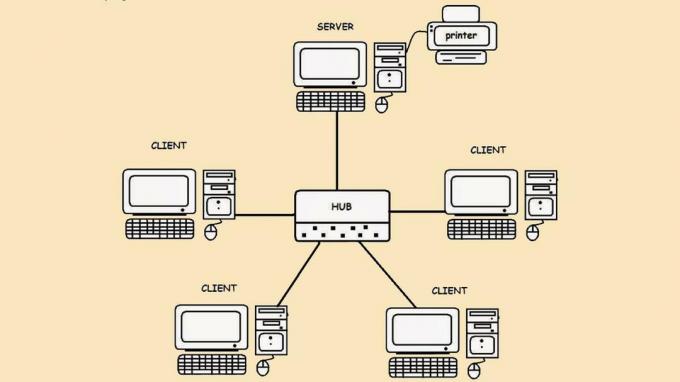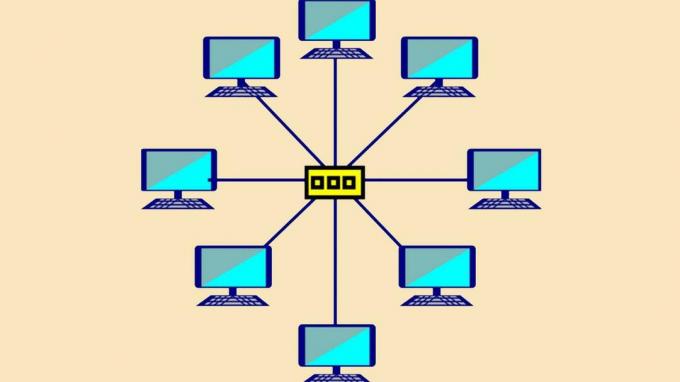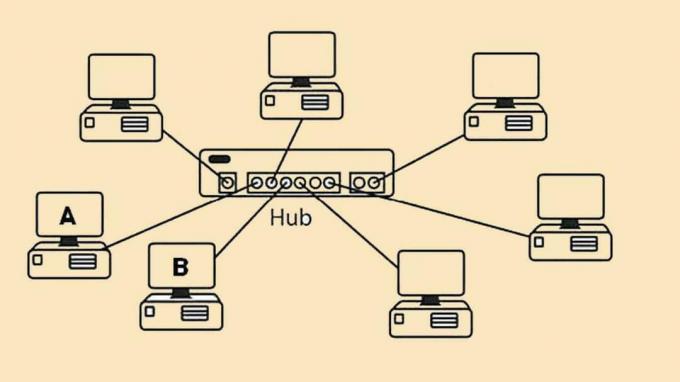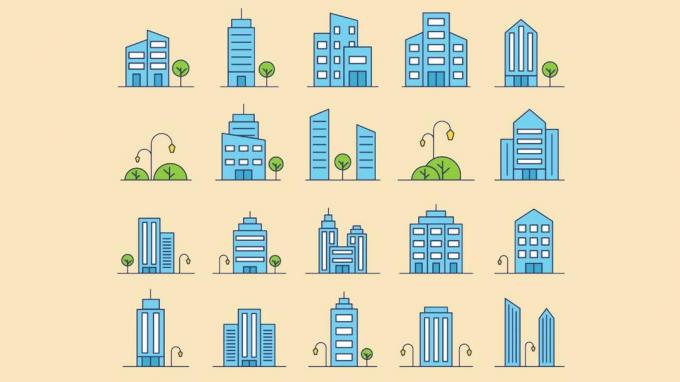Star Topology: Image, Definition, Strengths & Disadvantages
As with other topologies, the star topology is also connected through a device called a switch or hub.
The switch here functions as a receiver as well as a successor of signals sent from one computer to another.
As for the transmission media, it uses a UTP cable that has been equipped with a connector called RJ 45.
Table of contents
Definition

Star topology or also referred to as star topology is a network topology with the following methods: convergence from the central node to each user node so that it looks like a star.
In the application of the star topology, it is included in the category of medium cost to build it.
This type of topology is often applied as a computer network topology found in companies that adhere to the flow of centralized coordination.
It is intended that all data that will be sent is first filtered through the central server, then then distributed to other nodes.
Traits or Characteristics

The main characteristic or characteristic of the star topology is the use of switches or hubs that connect each server to the client computer.
Because the location of the hub is in the middle of the network, making this topology shaped like a star, that's why this network is called a star topology.
Some important points related to the characteristics of the star topology include the following:
- Using the type of UPT cable and using an RJ45 connector.
- At each node, communication will take place directly from the device by means of a hub or switch.
- If there is damage to one node, only the problematic node will be disturbed, while for other nodes will not be disturbed and will not cause problems in all traffic network.
- Traffic from this network system will follow the flow of nodes to the destination node and then will return again to convey the results of data transmission.
- Easy to expand because each node has only one cable that is directly connected to the central node.
- Short cables can be used because they are sufficient to handle traffic on this network.
- If every data packet that enters the hub is extended to all connected nodes, the network performance will be weak or low.
Advantages

It is common knowledge that each tapology has its advantages and disadvantages. So in its application must be adapted to the needs of the network itself.
The following are some of the advantages or advantages of a star topology, including:
1. Can be used for many server computers with clients
By implementing a star topology, you can manage servers with a large number of client computers.
For the use of computers in the room or building usually can reach about 30 to 50 units.
Data access from between computers can still be handled with a star topology network.
2. The transfer speed in computer networks is very large
By applying a star topology on a computer network, all computer servers or connected users will get the same speed and data transfer.
So you will more easily improve the efficiency of network usage.
3. Very light for maintenance
Maintenance in the topology will be much easier or lighter, you just need to observe the status of the server, hub or computer switch along with a cable that connects the hub to the computer.
If one of the client computers is damaged on the network, then it is enough to look at the condition of the cable being damaged, without having to look at all the cables one by one.
Of course, the maintenance and monitoring of the machine will be easier and lighter.
4. Can use a variety of cables
Star topology is very compatible with various types of cables that exist in computer networks.
5. Ease of network operation
Its use and installation of the topology is very easy, so many choose to use the star topology in the construction of a computer network.
6. Easier for development
Computer networks that implement a star topology are easy to develop.
Of course, if you really want to increase the number of users or client computers, you only need to buy a cable as well just connect it directly to a hub or switch that is used as a central data node on an existing network made.
This is advantageous because there is no need to re-install the cable which will certainly take a lot of time.
Deficiency

The following are some of the shortcomings that exist in the star topology, including:
1. Higher network building costs
Although maintenance is easy, for the first installation will require a lot of materials to be prepared to build this topological network.
So it can be estimated that the costs used will be higher when compared to other types of topologies.
The number of cables used and this hub can make the cost higher.
2. Heavy traffic can reduce data transfer speed
In a star topology, if there is a very heavy traffic it can reduce the speed of data transfer and can reduce the frequency of the computer network itself.
3. It takes a lot of cables
Its users will use a lot of cables. Because in making this star topology each client will need its own cable to be connected to a hub or switch.
4. Switch or hub needs attention
The hub or switch in the star topology is a piece of hardware that acts as the main function.
Therefore, the maintenance of this tool must also be considered. Because, if there is damage that occurs in one of the components of the hub, then it will result in connection and data transfer on the entire network will be disrupted or damage.
Operation

The following is the operation of the star topology, including:
- If you decide to use a star topology in creating a computer network, then you have to make each computer that is used as a user equipped with a cable.
For example, if you have 25 client computers, you will need 25 cables so that the star topology network can work well and optimally on each computer. - The hub that is connected to the data package provider server must be ready to become the center of a computer network.
- Then, attach the cable to the hub port or switch that will be used as the center.
- If each cable is ready to be installed, then connect the cable to the computer that will be used as a client.
- That way, each client will get the same data that is on the server as the center as well as the source of data packets.
- When sending data between devices, the data will go through the hub or switch which is first forwarded to the destination device.
The use of star topology is not only conventional, but there is also the term hybrid star topology. But basically, the topology is the same as the star topology in general.
The difference is only in cable users who often use various types of cables in computer networks.
The use of the cable will determine the quality of the data transfer speed that can be done by the server and the hub to the user.
You need to know, the better the quality of the type of cable used, the better the quality of signal transfer and data packets will be.
Procedure
For example, a company has a computer network that uses a star topology, where several computers are connected to a central device called a hub or switch.
The central device will then store a list Content Addressable Memory (CAM) into his memory.
The CAM will then store all the addresses of the computer devices connected to the hub.
Sample case:

In the picture above, the hub does not have memory for the data storage needs of the devices connected to the computer.
So, when computer A is about to send a message with computer B, the hub will then first check all the addresses of the computers connected to the hub.
This procedure is commonly referred to as Address Resolution Protocol (ARP), with this method, the hub can find the address of the packet that will later be addressed, then will forward it.
Another case when using a switch.
If computer A wants to send data with computer B, then computer A will send a message to the switch device.
Then the switch will check the address to be addressed using the CAM list. Only then, the hub will forward it to computer B.
Function

The following are some of the functions of the star topology, including:
- As a liaison media from one computer to another on a computer network, whether the computer is used as a server or as a client.
- To connect hardware to other network components, such as access points, routers, modems and other hardware.
Implementation

The use of this topology is generally used in computer networks consisting of 20 to 30 computers.
And the implementation or implementation is usually done in the following locations:
- Office
- Cafe
- Agency
- School
- Company
- And others
